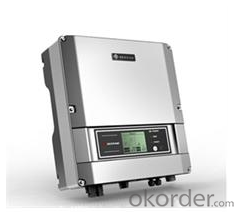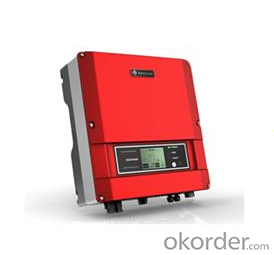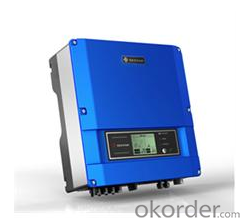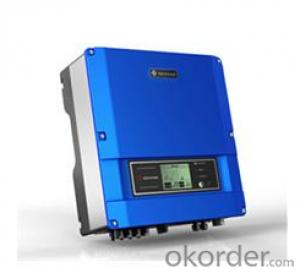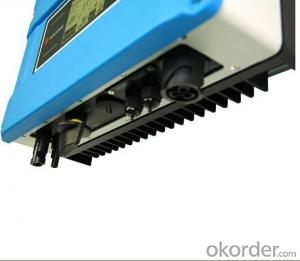Solar Inverter in Pakistan - On Grid Solar Inverter GS4600-SS
- Loading Port:
- Shanghai
- Payment Terms:
- TT OR LC
- Min Order Qty:
- 10 unit
- Supply Capability:
- 100 unit/month
OKorder Service Pledge
OKorder Financial Service
You Might Also Like
GW4600-SS
GW4600-SS photovoltaic inverter is suitable for home rooftop photovoltaic system, designed under modern industrial concept. There are three colors for option with fashionable appearance. The maximum output power of this model can reach 5100W. It is not only the largest one among GoodWe single-phase inverters, but also the model with the maximum power using single-tube design. Besides, it maintains extremely higher conversion efficiency, uses natural heat dissipation and has an extremely wide range of input voltage and input current. It holds a safe lead among the same level of products.
| DC Input Data | Max.PV-generator power[W] | 5400 |
| Max.DC voltage[V] | 580 | |
| MPPT voltage range[V] | 125~450 | |
| Turn on DC voltage[V] | 125 | |
Max.DC work current[A] | 20 | |
| Number of inputs/MPP trackers | 3/1 | |
| DC connection | MC IV Connector | |
| Self-energy consumption[W] | <5< td=""> | |
| AC Output Data | Nominal AC power[W] | 4600 |
| Max.AC power[w] | 5100 | |
| Max.output current[A] | 25 | |
| Nominal output voltage range | According to VDE0126-1-1/AI, RD1663, ENEL, G83,G59,SAA | |
| AC grid frequency | According to VDE0126-1-1/AI, RD1663, ENEL, G83,G59,SAA | |
| THDi | 〈1% | |
| Power factor | ~1 (Norminal power) | |
| AC connection | Single phase | |
| Efficiency | Max.efficiency | 97.8% |
| European efficiency | 97.4% | |
| MPPT adaptation efficiency | >99.5% | |
| Safty Equipment | Leakage current monitoring unit | Integrated |
| DC disconnector switch | Optional | |
| Islanding protection | AFD | |
| Grid monitoring | According to VDE 0126-1-1/AI,AS4777.1/2/3, RD1663, ENEL,G83,G59-2 | |
| Normative Reference | EMC compliance | EN 61000-6-1,EN 61000-6-2, EN 61000-6-3,EN 61000-6-4 |
| Safety compliance | According to IEC 62109-1,AS3100 | |
| General Data | Dimensions(W*H*D) [mm] | 390*417*142 |
| Net weight [kg] | 18 | |
| Housing | For outdoor and indoor | |
| Mounting information | Wall mounting | |
| Operating temperature range | -20~60℃(up 45℃ derating) | |
| Relative humidity | 0 ~ 95% | |
| Site altitude[m] | 2000 | |
| IP proection class | IP65 | |
| Topology | Transformerless | |
| Cooling | Nature convection | |
| Noise level[dB] | 〈25 | |
| Display | 4"LCD | |
| Communication | USB2.0;RS485(Wireless/Bluetooth optional) | |
| Standard warranty[years] | 5/10(optional) |
- Q: Can a solar inverter be used for both single-phase and three-phase applications?
- No, a solar inverter cannot be used for both single-phase and three-phase applications. The type of inverter required depends on the specific electrical requirements of the system. Single-phase inverters are designed for single-phase applications, while three-phase inverters are specifically designed for three-phase applications.
- Q: What is the role of a grid-tie inverter in a solar PV system?
- The role of a grid-tie inverter in a solar PV system is to convert the direct current (DC) electricity generated by the solar panels into alternating current (AC) electricity that can be used to power electrical devices in a home or business. In a solar PV system, the solar panels produce DC electricity when exposed to sunlight. However, most homes and businesses use AC electricity, which is the standard form of electricity provided by utility companies. This is where the grid-tie inverter comes in. The grid-tie inverter takes the DC electricity produced by the solar panels and converts it into AC electricity that is compatible with the electrical grid. It ensures that the electricity generated by the solar panels is synchronized with the utility power and can be seamlessly integrated into the existing electrical system. One of the key functions of a grid-tie inverter is to match the frequency, voltage, and phase of the AC electricity generated by the solar panels with that of the utility power. This synchronization is crucial to ensure a smooth flow of electricity between the solar system and the grid, and to prevent any disruptions or damage to the electrical system. Additionally, a grid-tie inverter also monitors the electrical grid for safety reasons. It constantly checks the grid for any voltage or frequency fluctuations and can automatically disconnect from the grid in the event of a power outage or grid failure. This feature is important to protect the safety of electrical workers who may be repairing the grid during an outage. Furthermore, a grid-tie inverter allows for net metering, which is a billing arrangement where excess electricity generated by the solar system can be fed back into the grid. This means that if the solar system produces more electricity than is being used, the excess energy can be sent back to the grid and the homeowner or business owner can receive credits for the excess energy produced. This can help offset energy costs and potentially result in monetary savings. Overall, the grid-tie inverter plays a vital role in a solar PV system by converting the DC electricity generated by the solar panels into AC electricity that can be used to power electrical devices, ensuring synchronization with the electrical grid, monitoring the grid for safety, and enabling net metering for potential financial benefits.
- Q: Can a solar inverter work without batteries?
- Yes, a solar inverter can work without batteries. Solar inverters are devices that convert the direct current (DC) produced by solar panels into alternating current (AC) which can be used to power household appliances or fed into the electrical grid. While batteries can store excess energy produced by the solar panels, they are not necessary for the basic functioning of a solar inverter. The inverter can directly convert the DC power into AC power for immediate use without the need for energy storage.
- Q: What is the role of a display or user interface in a solar inverter?
- The role of a display or user interface in a solar inverter is to provide a means for users to monitor and interact with the inverter's functionalities and data. It allows users to view real-time information about the solar power generation, system status, and any potential issues or errors. Furthermore, the user interface enables users to adjust settings, configure preferences, and troubleshoot problems if needed. Overall, the display or user interface enhances the usability and control of the solar inverter for users.
- Q: Are there any safety concerns associated with solar inverters?
- Yes, there are some safety concerns associated with solar inverters. One of the main concerns is the risk of electrical shock or fire due to faulty installation or maintenance. Additionally, there can be potential hazards from exposure to high voltage DC electricity during installation or repairs. It is important to follow proper installation procedures and adhere to safety guidelines to mitigate these risks.
- Q: Can a solar inverter be used with different types of monitoring systems?
- Yes, a solar inverter can be used with different types of monitoring systems. Solar inverters are designed to convert the direct current (DC) electricity produced by solar panels into alternating current (AC) electricity that can be used in homes or businesses. While some inverters come with built-in monitoring systems, they can also be connected to external monitoring systems that provide more advanced data and analytics. This allows users to monitor and manage their solar power generation and consumption effectively, regardless of the monitoring system they choose to use.
- Q: Can a solar inverter be used with different types of tracking algorithms?
- Yes, a solar inverter can be used with different types of tracking algorithms. The primary function of a solar inverter is to convert the direct current (DC) generated by solar panels into alternating current (AC) that can be used in homes or businesses. Tracking algorithms, on the other hand, are responsible for optimizing the performance of solar panels by adjusting their orientation and tilt angles to maximize sunlight exposure. Solar inverters can integrate with various tracking algorithms to ensure efficient operation and improve energy generation.
- Q: Can a solar inverter work during a power outage?
- No, a solar inverter cannot work during a power outage.
- Q: How does a solar inverter handle voltage fluctuations in the grid?
- A solar inverter handles voltage fluctuations in the grid by constantly monitoring the grid voltage and adjusting its own output voltage accordingly. When the grid voltage drops, the inverter increases its output voltage to compensate, and conversely, when the grid voltage rises, the inverter decreases its output voltage. This helps to stabilize the voltage and ensure that the solar system remains connected and operational even during fluctuations in the grid.
- Q: How does the input voltage range affect the performance of a solar inverter?
- The input voltage range of a solar inverter directly impacts its performance. A wider input voltage range allows the inverter to adapt to various solar panel configurations and environmental conditions, maximizing the system's overall efficiency. A limited input voltage range may result in reduced efficiency and output power, as the inverter may not be able to effectively convert the varying voltages produced by the solar panels. Additionally, a wider input voltage range provides flexibility in system design and allows for the incorporation of additional solar panels in the future without the need for significant modifications.
Send your message to us
Solar Inverter in Pakistan - On Grid Solar Inverter GS4600-SS
- Loading Port:
- Shanghai
- Payment Terms:
- TT OR LC
- Min Order Qty:
- 10 unit
- Supply Capability:
- 100 unit/month
OKorder Service Pledge
OKorder Financial Service
Similar products
Hot products
Hot Searches
Related keywords



